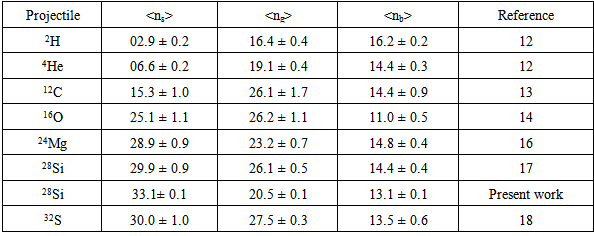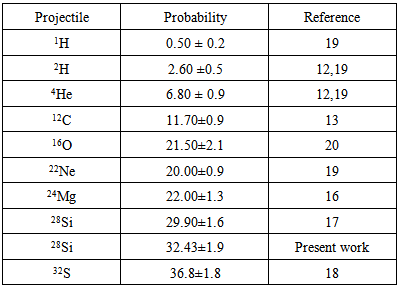-
Paper Information
- Next Paper
- Paper Submission
-
Journal Information
- About This Journal
- Editorial Board
- Current Issue
- Archive
- Author Guidelines
- Contact Us
Journal of Nuclear and Particle Physics
p-ISSN: 2167-6895 e-ISSN: 2167-6909
2015; 5(1): 1-9
doi:10.5923/j.jnpp.20150501.01
Study Some Features of the Total Disintegration Events of Heavy Emulsion Targets from 28Si at 4.5 A GeV/c
A. Abd El-Daiem
Department of Physics, Faculty of Science, Sohag University, Sohag, Egypt
Correspondence to: A. Abd El-Daiem , Department of Physics, Faculty of Science, Sohag University, Sohag, Egypt.
| Email: |  |
Copyright © 2015 Scientific & Academic Publishing. All Rights Reserved.
In the present work we investigate some results based on the study of the correlations between the multiplicity distribution and the projectile fragments , as well as the correlations between the black and grey fragments were given and the total disintegration events produced by 4.5 A GeV/c 28Si-AgBr interactions are analyzed to investigate the characteristics of secondary charged particles in such collisions. The multiplicity distributions of relativistic charged particles, grey and black can be well represented by Gaussian distribution. The average multiplicity of black particles is found to decrease with the mass of the projectile increasing, while that of grey particles found to increase with the mass of projectile increasing.
Keywords: Correlations between the multiplicity distributions, Relativistic heavy ion collision, Total disintegration
Cite this paper: A. Abd El-Daiem , Study Some Features of the Total Disintegration Events of Heavy Emulsion Targets from 28Si at 4.5 A GeV/c, Journal of Nuclear and Particle Physics, Vol. 5 No. 1, 2015, pp. 1-9. doi: 10.5923/j.jnpp.20150501.01.
Article Outline
1. Introduction
- The study of heavy ion interactions at high energies is an important up to date field of particle and nuclear physics. The study of such interactions is attracting a significant and steadily increasing interest in the search of quark gluon plasma predicted by various theories originating from nuclear reactions at high energies. However, the intermediate goal is to study the characteristics of secondary charged particles produced in relativistic heavy ion reactions. Many current theoretical and experimental activities [1-8] are for analyzing the data of high energy collisions in terms of selected central events. In the study of the inelastic interactions of relativistic heavy ions with AgBr nuclei using the nuclear emulsion as target and detector, the investigators are attracted by events with complete destructions because during such collisions, nuclear matter might be compressed several times in density and consequently several interesting phenomena are expected to occur. The study of central collisions of relativistic nuclei can throw light on the possibility of investigating the effects of multi-nucleon interactions, collective properties of nuclear matter, production of shock waves in nuclear matter, and its possible transitions to the quark matter. Furthermore, some characteristics of central collisions are more critical to the choice of collision model. Thus, experimental data on central collisions may also be used to improve the existing models for explaining the dynamics of multiparticle production in heavy ion interactions at high energies. The goal of the research is to perform a systematic analysis of target fragmentation in 28Si with emulsion at 4.5 A GeV/c. The second section describes the experimental materials. The correlations between the multiplicity distributions and the projectile fragments are given in the third. The criterion nh ≥ 28 is used to select events for the total disintegration of AgBr nuclei in nuclear emulsion fourth. The last section gives our conclusion.
2. Experimental Details
- The present research was carried out using stacks of Br-2 nuclear emulsion exposed to 4.5 A GeV/c 28Si beam at the Dubna synchrophastron. The stacks have dimensions of 20cm × 10cm × 600 µm. The intensity of irradiation was ≈ 104 particle cm2 and the beam diameter was about 1cm. Along the track double scanning was carried out, fast in the forward and slow in the backward direction .The scanned beam tracks were further examined by measuring the δ-electron density on each of them to exclude the tracks having charge less than the beam particle charge Zb. According to the range L in the emulsion and the reactive ionization g* = g/g0 (where g is the particle track ionization and g0 is the ionization of relativistic shower tracks in the narrow forwards cone of an opening angle of θ ≤3° all charged particles in the found interactions were classified into four categories, namely singly charged shower (β >0.7) grey (0.3 ≤ β ≤ 0.7), black (β < 0.3) and projectile fragments particles , their numbers in an interaction are denoted by ns, ng, nb, and nf respectively. The shower tracks correspond to relativistic charged particles, where as grey and black tracks are produced by relatively slow particles emitted from the target nuclei. Grey tracks are mostly recoil protons with 40 < E< 400 MeV and range R >3 mm in emulsion, with less than a few percent admixture of low energy pions. Black tracks are due to slow particles and evaporated target fragments with E<40 A MeV and range R ≤ 3 mm. The sum of grey and black tracks in an interactions is represented by nh (= ng+nb), and these tracks are thought to originate from heavily ionizing charged particles. Projectile fragments have momentum per nucleon almost equal to that of the parent nucleus, so they are essentially emitted inside a narrow forward angular cone centred around the direction of incident beam, the total charge of the projectile fragments Q = ∑ ni zi where ni is the number of fragments of charge zi in an event.
3. Correlation between Multiplicity Distribution and Projectile Fragments
- The charges of the projectile fragments can be measured in a nuclear emulsion by the grain density and δ-ray counting methods [9] as well as the lacunarity technique [10] SA. The charge identification of relativistic fragments (of z ≥2) has been made by measuring the gap length along the track which is associated with the energy less. To identify the charge of a track by this method, one measures the frequency of the gaps with a length ≥ 2µm in a distance of 2 cm along the track starting from the vertex. Thus by counting the number of gaps of two tracks and knowing the charge of one, then the charge of the other can be determined from the inverse proportionality of gaps with charges. In this research, the charges of the projectile spectator were identified by means of the δ-ray counting method. Let nsi and nz denote the experimental of track δ-ray densities of the incident 28Si nucleus and projectile fragment with charge. In nuclear emulsion we can measure the charges of all projectile fragments. Then the number interacting nucleons of the projectile nucleus on average nint = Ap-(Ap/np) Q, since Q is the total charge. The relationship between ni (i=g,b,h) with Q should be observed [11]. Figure 1 shows the correlations between ni and Q at 4.5 A GeV/c for 28Si with emulsion collision. Figure 1 correspond the correlation
 with Q. One can see that negative correlations between
with Q. One can see that negative correlations between  and Q are obtained. The ni distribution for events with different Q regions are shown in Figures 2, 3 and 4 respectively. The histogram correspond to the experimental data for 28Si with emulsion collisions, Figures 2,3 and 4 are the results for events with Q = 0, Q = 2-7 and Q = 8-14. One can see that the multiplicity of fragments has a wide and even distribution at small Q. The number of events with low multiplicity increases and the number of events with high multiplicity decreases with increasing value of Q. The multiplicity description becomes narrow at great Q. The average multiplicity of events with different Q are shown in Table 1. One can see that the average multiplicity decrease with increasing value of Q. The negative correlation between ni and Q is determined by the nuclear geometry.
and Q are obtained. The ni distribution for events with different Q regions are shown in Figures 2, 3 and 4 respectively. The histogram correspond to the experimental data for 28Si with emulsion collisions, Figures 2,3 and 4 are the results for events with Q = 0, Q = 2-7 and Q = 8-14. One can see that the multiplicity of fragments has a wide and even distribution at small Q. The number of events with low multiplicity increases and the number of events with high multiplicity decreases with increasing value of Q. The multiplicity description becomes narrow at great Q. The average multiplicity of events with different Q are shown in Table 1. One can see that the average multiplicity decrease with increasing value of Q. The negative correlation between ni and Q is determined by the nuclear geometry.
|
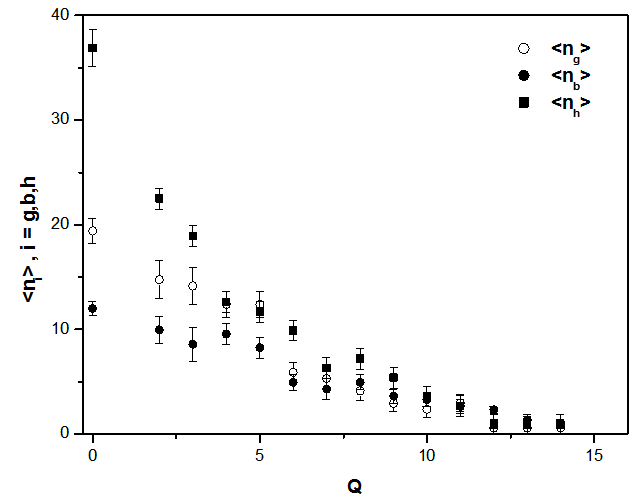 | Figure 1. Correlation between the target fragment projectile and the system bound charge in 28Si with emulsion at 4.5 A GeV/c |
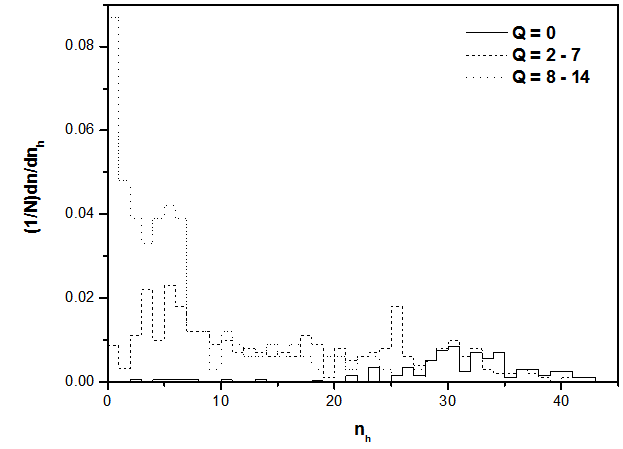 | Figure 2. The nh distribution for events with different Q values in emulsion collisions at 4.5 A GeV/c |
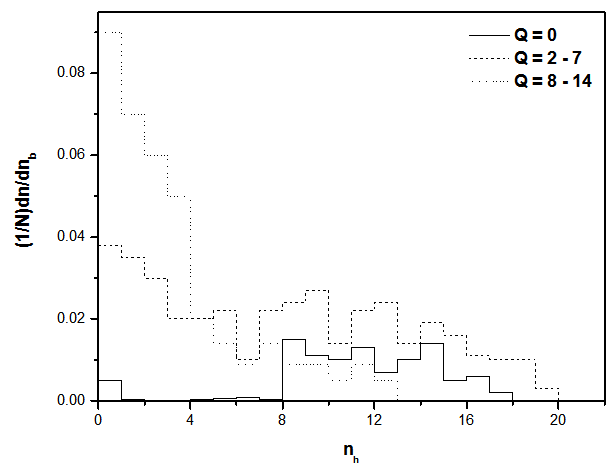 | Figure 3. The nb distribution for events with different Q values in emulsion collisions at 4.5 A GeV/c |
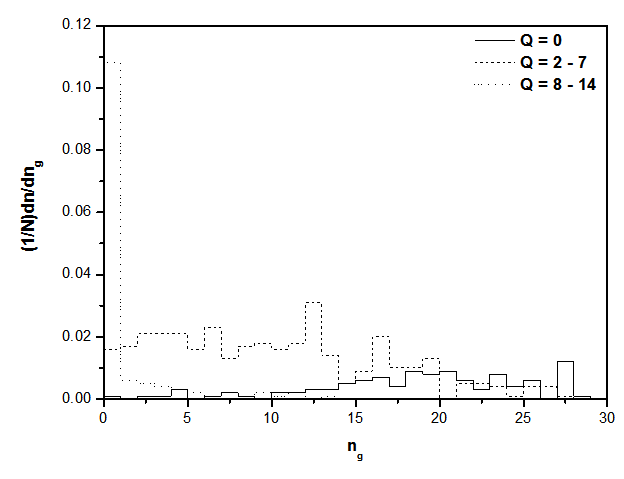 | Figure 4. The ng distribution for events with different Q values in emulsion collisions at 4.5 A GeV/c |
4. Total Destruction of AgBr Emulsion Nuclei Induced by 4.5 A GeV/c 28Si Ions
- Through total length of 8712 cm of beam track scanned, a total of 1000 events attributed to inelastic interactions of 28Si projectile with emulsion nuclei were found, given rise to a mean free path λ = 8.71 ± 0.30cm. In the present work, we study total destruction nh ≥ 28 of AgBr emulsion nuclei 150 events induced by 4.5 A GeV/c 28Si are selected for final analysis. The average multiplicities of shower, grey and black emitted from the total destruction events are given in Table 2. This Table presents the average multiplicities from other total destruction events by relativistic heavy ions at the same energy.
|
 increases. This result is an agreement with that in Ref. [14], in which it has been found that the ratio between
increases. This result is an agreement with that in Ref. [14], in which it has been found that the ratio between  and the number of the projectile nucleons participating directly in the interactions is approximately equal to the average multiplicity of the hadron – nucleon interaction. Moreover, when the mass of the projectile increasing, the
and the number of the projectile nucleons participating directly in the interactions is approximately equal to the average multiplicity of the hadron – nucleon interaction. Moreover, when the mass of the projectile increasing, the  which is a measure of both the number of interacting projectile nucleons and the corresponding number of intranuclear collisions, increases. It is also of interest to note that the
which is a measure of both the number of interacting projectile nucleons and the corresponding number of intranuclear collisions, increases. It is also of interest to note that the  decreases with the mass of the projectile increasing. These features may be explicated based on the fireball model [15]. By using this model, the grey particles come from participant volume and the number of participating nucleons increases with the increase of the volume of the cylinder cut in the target nucleus by the projectile. This cylinder volume increase with the increase of the projectile mass, and consequently the value of
decreases with the mass of the projectile increasing. These features may be explicated based on the fireball model [15]. By using this model, the grey particles come from participant volume and the number of participating nucleons increases with the increase of the volume of the cylinder cut in the target nucleus by the projectile. This cylinder volume increase with the increase of the projectile mass, and consequently the value of  increases. Since the size of the target is limited, the
increases. Since the size of the target is limited, the  decreases as the number of grey particles increases. In the present work, the probability of the total destruction of AgBr nuclei induced by very fast projectiles in the probability P is defined as the ratio between the number of events having nh ≥28 to the total number of disintegrations involving AgBr nuclei i.e P = nTD / nAgBr. The probabilities of the total destruction of AgBr nuclei in heavy ion interactions at 4.5A GeV/c are found in Table 3.
decreases as the number of grey particles increases. In the present work, the probability of the total destruction of AgBr nuclei induced by very fast projectiles in the probability P is defined as the ratio between the number of events having nh ≥28 to the total number of disintegrations involving AgBr nuclei i.e P = nTD / nAgBr. The probabilities of the total destruction of AgBr nuclei in heavy ion interactions at 4.5A GeV/c are found in Table 3.
|
 | (1) |
 | (2) |
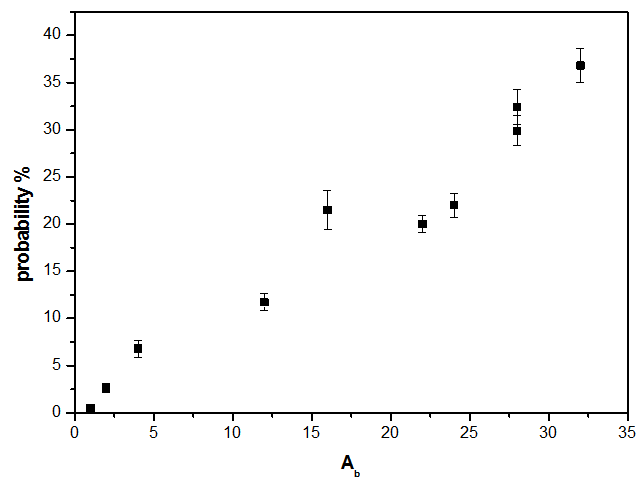 | Figure 5. Variation in the probability of total destruction of AgBr nuclei with the mass of projectile |
 | Figure 6. Multiplicity distribution of shower particles in total destruction events of 28Si AgBr at 4.5 A GeV/c |
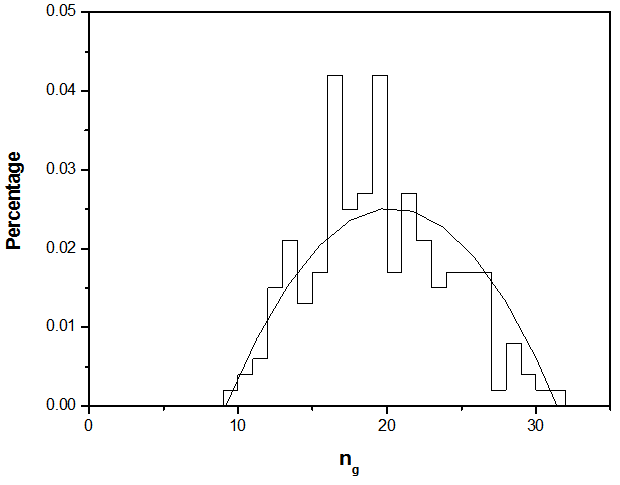 | Figure 7. Multiplicity distribution of grey particles in total destruction events of 28Si AgBr at 4.5 A GeV/c |
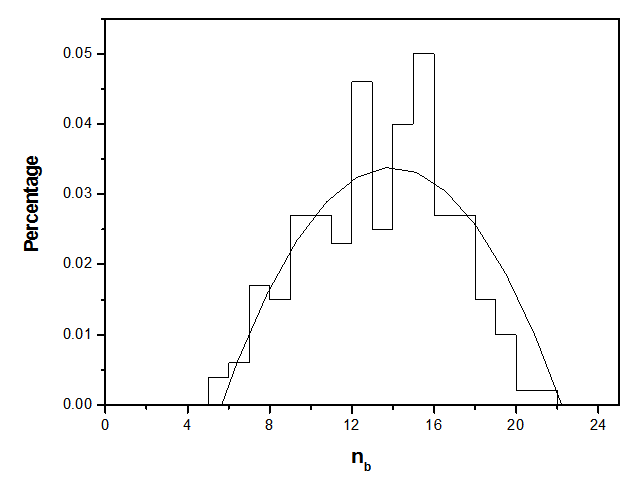 | Figure 8. Multiplicity distribution of black particles in total destruction events of 28Si AgBr at 4.5 A GeV/c |
 = Ap-2Q. Specific multiplicities of the produced particles is an important parameter of nucleus- nucleus collisions and indicated how effective an incoming nucleon is in producing particles in subsequent collisions [18]. In Figures 10-12 we show the dependences of the specific multiplicities of shower grey, and black particles with nh < 28 generated by 28Si nuclei. The value of this quantity is systematically higher for total destruction events than for events with nh < 28. (The differences in dependence of
= Ap-2Q. Specific multiplicities of the produced particles is an important parameter of nucleus- nucleus collisions and indicated how effective an incoming nucleon is in producing particles in subsequent collisions [18]. In Figures 10-12 we show the dependences of the specific multiplicities of shower grey, and black particles with nh < 28 generated by 28Si nuclei. The value of this quantity is systematically higher for total destruction events than for events with nh < 28. (The differences in dependence of  / nint and
/ nint and  /nint on nint between the two groups of events are noticeable). From Figures 10-12 we note that
/nint on nint between the two groups of events are noticeable). From Figures 10-12 we note that  (i=g,b) in the case of total destruction events , increases with the decrease of the value of nint. The ratio
(i=g,b) in the case of total destruction events , increases with the decrease of the value of nint. The ratio  constant, which shows the evidence for validity of the approximation in assuming that nucleus – nucleus collisions at an energy equal a few GeV per nucleon of nucleon – nucleon collision. It is evident that the specific multiplicities of all types of charged particles depend substantially on the impact parameter of the nucleus – nucleus collision.
constant, which shows the evidence for validity of the approximation in assuming that nucleus – nucleus collisions at an energy equal a few GeV per nucleon of nucleon – nucleon collision. It is evident that the specific multiplicities of all types of charged particles depend substantially on the impact parameter of the nucleus – nucleus collision.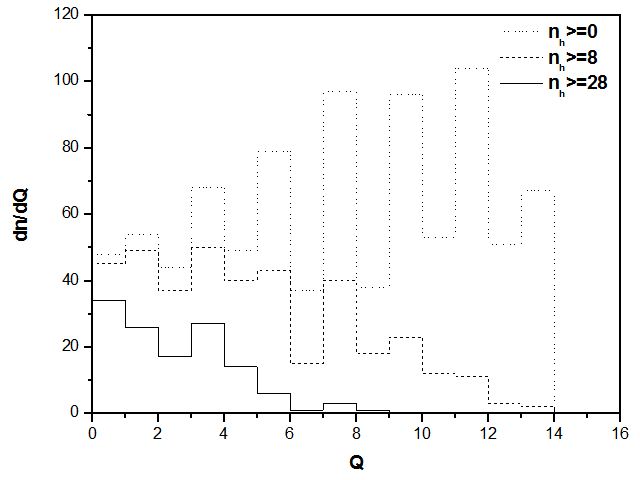 | Figure 9. Q distribution for events with nh ≥ 8 , nh ≥28 and total sample for 28Si with emulsion collisions at 4.5 A GeV/c |
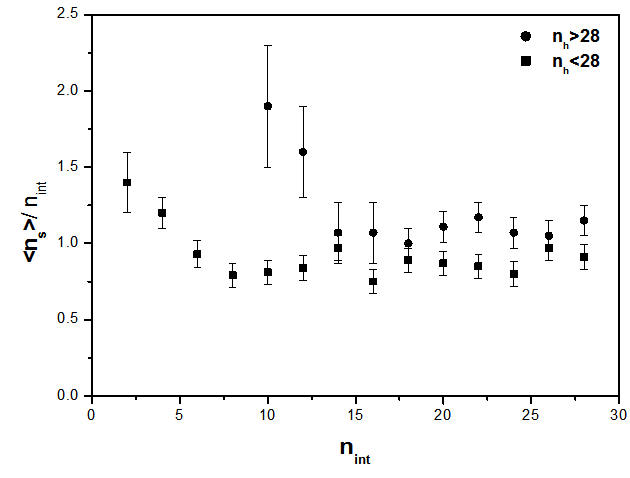 | Figure 10. Dependence of the specific multiplicity of shower particles  on nint on nint |
 | Figure 11. Dependence of the specific multiplicity of grey particles  on nint on nint |
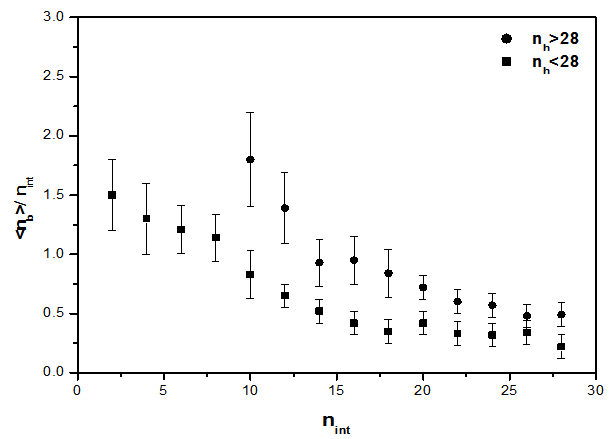 | Figure 12. Dependence of the specific multiplicity of black particles  on nint on nint |
5. Conclusions
- From the basis of the present investigation, we can make the following conclusions:1- Correlation between multiplicities distribution and projectile fragments, we can see that negative correlations between
 and Q, the number of events with high multiplicity decreases with increasing value of Q and the multiplicity distribution becomes narrow at great Q.2- The probability of the total destruction of AgBr nuclei increases with the mass of the projectile. This result may be explained by the fact that at high energies the inelastic cross-section increases with the projectile mass.3- The multiplicity distribution of shower, grey and black projectile agree with the Gaussian distribution.4- The average multiplicities
and Q, the number of events with high multiplicity decreases with increasing value of Q and the multiplicity distribution becomes narrow at great Q.2- The probability of the total destruction of AgBr nuclei increases with the mass of the projectile. This result may be explained by the fact that at high energies the inelastic cross-section increases with the projectile mass.3- The multiplicity distribution of shower, grey and black projectile agree with the Gaussian distribution.4- The average multiplicities  and
and  increase rapidly while
increase rapidly while  decrease with the mass of projectile increasing. This result is agreement with the prediction of the fireball model.5- The ratio
decrease with the mass of projectile increasing. This result is agreement with the prediction of the fireball model.5- The ratio  constant, which indicates that the production of shower particles in nucleus – nucleus collisions can be considered as an incoherent super position of nucleon-nucleon collision.
constant, which indicates that the production of shower particles in nucleus – nucleus collisions can be considered as an incoherent super position of nucleon-nucleon collision. Abstract
Abstract Reference
Reference Full-Text PDF
Full-Text PDF Full-text HTML
Full-text HTML
